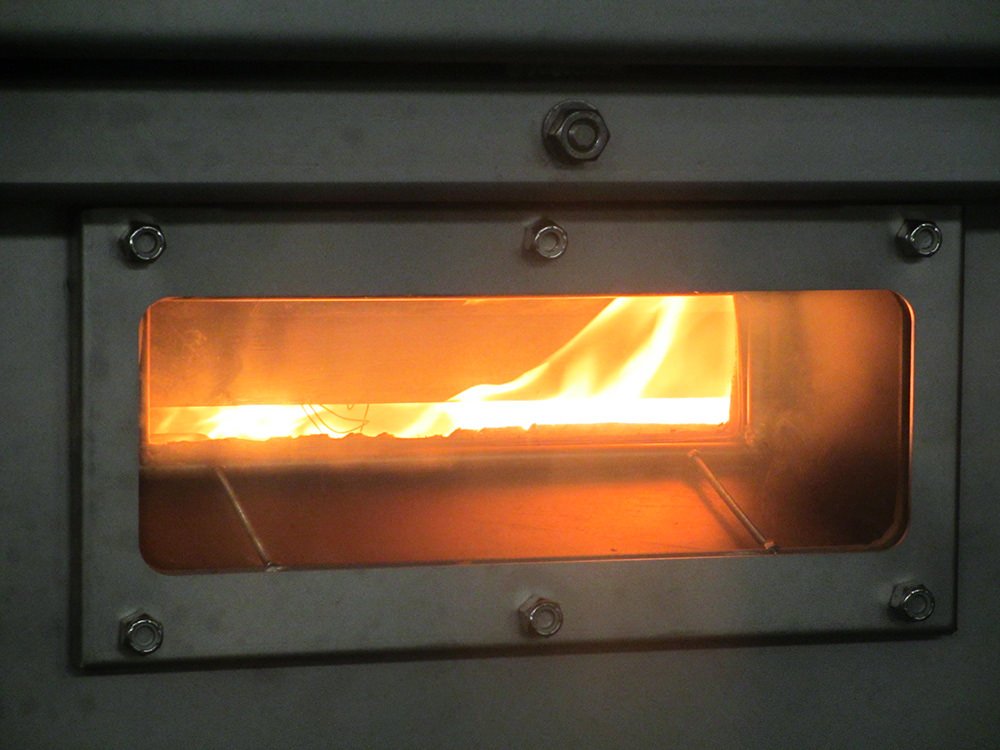ASTM E84 Steiner Tunnel
Compliance
ASTM E84, NFPA 255, UL 732, CAN/ULC-S102
The Steiner Tunnel (ASTM E84) is used to assess the surface burning characteristic of building materials.
The purpose of the test is to determine the comparative burning characteristics of the material under test by evaluating the spread of flame over its surface and the density of the smoke developed when exposed to a test fire, and thus to establish a basis on which surface burning characteristics of different materials are compared, without specific regard to all the end-use parameters that affect the surface burning characteristics.
A 24’ wide x 24” long sample is placed into a test chamber (Steiner Tunnel) and covered under a removable lid, and the sample is exposed to an 89kW output open flame. During the test, a forced airflow is provided from the upstream of the Steiner Tunnel in order for the material to burn. The distance of spread of flame is monitored through the glass windows on the side of the Steiner Tunnel, also the optical density of the light measuring system at the end of the exhaust duct is recorded by the computing system. The Spread Flame Index (FSI) and Smoke Developed Index (SDI) are calculated to assess the surface burning characteristic of the sample.
FSI is used to measure the speed of flame progress across the interior surface of the material, and SDI is used to measure the amount of smoke generated from burning material.
The National Fire Protection Agency (NFPA) 101 Life Safety Code requires that “Interior wall or ceiling finish that is required elsewhere in this Code to be Class A, Class B, to Class C shall be classified based on the test results from ASTM E84, NFPA 255, or UL 723.”
NFPA 255 & UL 723 are the equivalent test standard of ASTM E84. The performance requirements as below table.
| Flame Spread Index (FSI) | Smoke Developed Index (SDI) | |
|---|---|---|
| Class I / Class A | 0-25 | Max. 450 |
| Class II / Class B | 26-75 | Max. 450 |
| Class III / Class C | 76-200 | Max. 450 |
Steiner Tunnel consists of
Stainless steel SUS304 made Steiner Tunnel Furnace with firebrick interior for resistance to flame impact and good thermal insulation.
Double layer high-temperature-resistance glass observation window for observing and recording the flame spread distance.
Indicator for each glass windows for flame spread distance recording.
Cooling water circulation support bracket to support burning coverings.
Equipped with a 2mm thick 304 stainless steel water sealing tank to ensure no leakage of smoke during the test.
Stainless steel insulation body top cover, filled with high-temperature-resistant insulation firebrick inside.
Independent multi-functional exhaust pressure detection device, real-time monitoring of exhaust pressure changes during the test. Measurement range of 0 to 250Pa, accuracy of ±0.5Pa, system schematic pressure test accuracy of ±2Pa.
Equips with a frequency converter to change the air velocity, with a flow rate capacity not less than 8000m3/h, to be able to discharge the smoke generated by the combustion of the sample in time to ensure the safety of the test.
U-Shaped gas burner, able to output a standard 5.3MJ/min flame source, and can be controlled by a flowmeter according to different standards, with a measuring range of 0 to 160L/min.
Equips with ignition system to ensure the safety performance of the test, high voltage igniter, 44KV, 50mA, minimum high voltage of 1.8kVp for the ignition electrode.
Smoke measurement system, provides a separate signal processing system to ensure that the sensor is linear.
Automatic recording of temperature and smoke sensing signals, with a sample collection frequency of 1Hz.
Standard test software for automatic recording of system air velocity, temperature, smoke density, and other test data.


